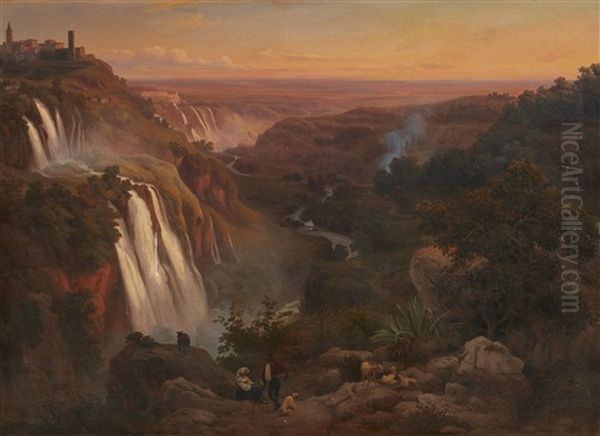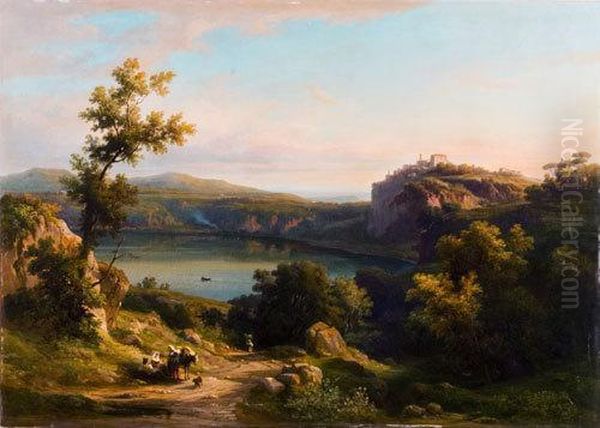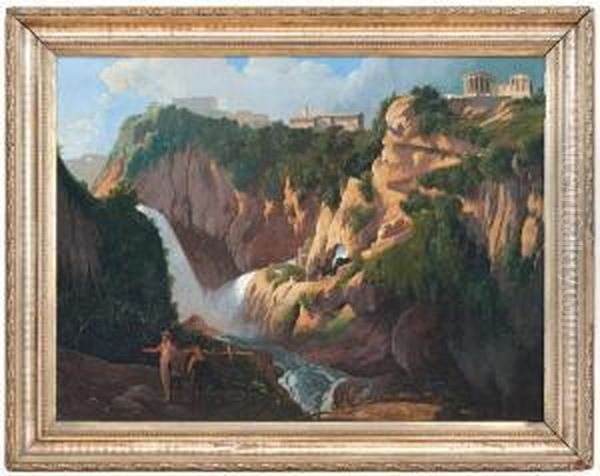Franz Knebel, a name perhaps not as universally recognized as some of his contemporaries, nonetheless carved a significant niche for himself within the rich tapestry of 19th-century European landscape painting. A Swiss artist by birth, Knebel dedicated much of his career to capturing the evocative beauty and timeless allure of the Italian peninsula, particularly its landscapes, which had enchanted artists for centuries. His work is characterized by a keen sensitivity to light, atmosphere, and the picturesque qualities of nature, placing him firmly within the Romantic tradition yet with a distinct observational clarity.
Early Life and Artistic Formation in Rome
Born in 1809, Franz Knebel, who also went by the name Charles-François Knebel, emerged during a period of profound artistic and cultural shifts across Europe. While the provided information initially presented some conflicting details regarding his early life and education, it's crucial to distinguish him from other notable figures bearing the Knebel surname, such as the German poet Karl Ludwig von Knebel, whose life and associations with Goethe belong to a different narrative.
The pivotal chapter in Franz Knebel the painter's development began with his move to Rome. The Eternal City, by the early 19th century, was an unparalleled hub for artists from across Europe and America. It was a living museum, a landscape steeped in history, and a source of inexhaustible inspiration. Here, Knebel is understood to have established his studio, immersing himself in the vibrant expatriate artistic community and the stunning natural environment of the Roman Campagna and its surrounding regions.
A significant connection in his Roman years was with Franz Keiserman (also spelled Kaisermann), another Swiss painter who was well-established in Rome. Keiserman, known for his accomplished landscape views, played an important role in Knebel's life. Following the death of Jean-François Knebel, Charles-François's brother, in 1822, Keiserman invited Charles-François to Rome. This relationship deepened, and Keiserman eventually formally adopted him. This association undoubtedly provided Knebel with guidance, studio support, and an entry into the professional art world of Rome.
The Allure of the Italian Landscape: Style and Influences

Franz Knebel's artistic output is predominantly focused on the Italian landscape, a theme that resonated deeply with the Romantic sensibilities of the era. Artists were drawn to Italy not just for its classical ruins but for the sublime beauty of its natural scenery – its dramatic coastlines, serene lakes, cascading waterfalls, and sun-drenched countryside. Knebel's work excels in capturing these elements with a refined technique and a poetic eye.
His style can be described as a blend of topographical accuracy and romantic idealization. While his views are recognizable and often depict specific locations, they are imbued with an atmospheric quality that transcends mere representation. He was particularly adept at rendering the effects of light – the golden glow of an Italian sunset, the cool shadows of a forest grove, or the hazy light of a summer afternoon. This mastery of light and shadow, or chiaroscuro, lent depth and emotional resonance to his canvases.
The influence of earlier masters of landscape painting, such as Claude Lorrain and Nicolas Poussin, who had themselves found inspiration in the Italian countryside centuries before, can be felt as a foundational undercurrent in the work of many 19th-century landscapists, Knebel included. However, Knebel's approach was also shaped by contemporary trends. The plein air (open-air) sketching movement, though more fully developed later in the century, had its roots in this period, with artists increasingly venturing out to capture nature directly.
Knebel's palette often featured a harmonious blend of blues, greens, and earthy tones, skillfully employed to convey the specific character of the Italian terrain. In works depicting scenes like Lake Nemi, for instance, he demonstrated a capacity to merge these hues to create a sense of tranquility and warmth, especially when capturing the crepuscular light of dusk.
Iconic Subjects: Tivoli and Lake Nemi
Among the many Italian locales that captured Knebel's imagination, Tivoli and Lake Nemi feature prominently in his known oeuvre, representing quintessential examples of his artistic preoccupations. These sites were popular destinations on the Grand Tour and had been painted by countless artists before him, yet Knebel brought his own distinct vision to these celebrated views.
Tivoli, with its dramatic waterfalls, ancient Roman villas, and lush vegetation, offered a perfect subject for an artist interested in the sublime and the picturesque. The Cascate di Tivoli (Waterfalls of Tivoli) were a particular draw, providing a dynamic interplay of water, rock, and foliage. Knebel's depictions of Tivoli would have aimed to capture both the raw power of nature and the historical resonance of the site.

Lake Nemi, a volcanic crater lake nestled in the Alban Hills southeast of Rome, was another favored subject. Known for its serene beauty and mythological associations (the "Mirror of Diana"), Nemi provided a contrast to the dramatic energy of Tivoli. Knebel's views of Lake Nemi often emphasize its tranquil atmosphere, the clarity of its waters, and the picturesque quality of the surrounding landscape, frequently bathed in the soft light of dawn or sunset. These paintings evoke a sense of peace and timelessness.
Representative Masterpieces
Two works frequently cited in relation to Franz Knebel are "Waterfall at Tivoli" and "Veduta del lago di Nemi" (View of Lake Nemi), which serve as excellent examples of his artistic skill and thematic focus.
"Waterfall at Tivoli" (1876)
This painting, documented as having been signed and dated "Roma 1876," showcases Knebel's ability to capture the grandeur of one of Italy's most famous natural spectacles. One can imagine the composition balancing the powerful rush of water with the ruggedness of the cliffs and the verdant foliage clinging to the rocks. The play of light on the cascading water and the misty spray would have been key elements, demonstrating his technical prowess in rendering different textures and atmospheric effects. The work, measuring 98 x 136 cm, was notably sold at Christie's, Düsseldorf, and has been associated with the Dr. Georg Schaefer Museum collection, indicating its perceived quality and historical value. Such a piece would aim to transport the viewer to the scene, allowing them to almost hear the roar of the water and feel the coolness of the spray.
"Veduta del lago di Nemi" (versions from 1862 and 1874)
Knebel produced multiple views of Lake Nemi, a testament to his fondness for the subject. A version dated 1862, for example, was recorded with Bonhams. Another, described as a favorite work of the artist and part of the Barratt Collection, Crowe Hall, Bath (measuring 99.5 x 138 cm), is praised for its "clever fusion of blue and green tones" and the "warm light of the setting sun," creating a beautiful depiction of the countryside at dusk. These paintings would likely emphasize the reflective surface of the lake, the gentle contours of the surrounding hills, and the distinctive Italian light that softens the landscape. The inclusion of small figures, perhaps local peasants or travelers, often served to animate such scenes and provide a sense of scale, a common practice in landscape painting of the period.
These works highlight Knebel's commitment to the Italian landscape, his ability to convey specific times of day and atmospheric conditions, and his skill in creating compositions that were both topographically recognizable and aesthetically pleasing.
Artistic Collaborations and Roman Connections

The artistic environment in Rome during the 19th century was highly collaborative, with artists often sharing studios, models, and ideas. Franz Knebel's primary artistic connection was, as mentioned, with his adoptive father, Franz Keiserman. Working within Keiserman's established studio would have provided Knebel with invaluable experience and exposure. While the source material is somewhat ambiguous about direct co-painting projects between Knebel and Keiserman, the mentorship and shared artistic environment were undoubtedly formative.
The provided information also mentions a collaboration between Franz Keiserman (referred to in one instance as "Franz Knebel, then called Franz Kaiserman," which likely refers to Keiserman before Charles-François Knebel's prominence or due to a name similarity) and the Italian artist Bartolomeo Pinelli (1781-1835). Pinelli was a prolific engraver, illustrator, and painter, particularly known for his lively depictions of Roman life, costumes, and brigands. The collaboration, dated between 1799 and 1803, involved Keiserman focusing on the landscape elements while Pinelli was responsible for the figures. This was a common practice, allowing specialists to contribute their respective strengths to a single work.
Although this specific Pinelli-Keiserman collaboration predates Franz (Charles-François) Knebel's most active period, his immersion in Keiserman's circle meant he would have been well aware of such practices. It's plausible that Knebel himself might have collaborated with figure painters or incorporated figures into his landscapes in a manner influenced by these established Roman artistic customs. The note about Pinelli providing "disegni fatti in Tivoli sul vero" (designs made in Tivoli from life) for "Knebel's" watercolors, which became part of Pinelli's estate, is intriguing, though the precise "Knebel" (Keiserman or Charles-François) and the nature of this exchange require further clarification from more specialized art historical research. It does, however, point to the interconnectedness of artists in Rome.
Knebel in the Context of His Contemporaries
To fully appreciate Franz Knebel's contribution, it's essential to place him within the broader context of 19th-century landscape painting and the vibrant artistic milieu of Rome. He was working during a golden age for landscape art, a period when nature was increasingly seen as a primary source of artistic inspiration and spiritual solace.
Many artists from across Europe and America flocked to Italy. Among his Swiss contemporaries who also achieved recognition for landscape painting were figures like Alexandre Calame (1810-1864), famed for his majestic Alpine scenes but who also painted in Italy, and Barthélemy Menn (1815-1893), an influential teacher and painter. François Diday (1802-1877), Calame's teacher, was another key figure in Swiss Romantic landscape painting.
In Rome, Knebel would have been aware of, and perhaps interacted with, artists from various national schools. The German-speaking contingent was particularly strong, including artists like Joseph Anton Koch (1768-1839), an earlier but highly influential figure whose heroic landscapes of the Roman Campagna set a precedent. Later figures like Oswald Achenbach (1827-1905) and his brother Andreas Achenbach (1815-1910) were renowned for their dramatic and often Italianate landscapes. Carl Blechen (1798-1840), another German, was noted for his more realistic and light-filled Italian views.
The British presence was also significant. While J.M.W. Turner (1775-1851) had made his transformative visits to Italy earlier, his influence on the perception of light and atmosphere in landscape was pervasive. Samuel Palmer (1805-1881), though more focused on a visionary English landscape, also spent time in Italy.
French artists like Camille Corot (1796-1875) spent crucial formative years in Italy, developing his sensitive approach to light and landscape that would prove so influential. His Italian studies are celebrated for their freshness and directness.
From the Nordic countries, painters like Johan Christian Dahl (1788-1857), a Norwegian, also traveled and painted in Italy, bringing a Northern European sensibility to Mediterranean light. Russian painters, too, were part of this international congregation, with Sylvester Shchedrin (1791-1830) being a notable example, celebrated for his coastal views and grottoes around Naples and Sorrento.
American artists of the Hudson River School, such as Thomas Cole (1801-1848) and Asher B. Durand (1796-1886), also made the pilgrimage to Italy, seeking to enrich their artistic vision. Cole, in particular, painted allegorical landscapes inspired by the Italian scenery and ruins. The Dutch painter Abraham Teerlink (1776-1857) was another long-term resident of Rome, known for his Italianate landscapes.
Italian artists themselves were, of course, actively depicting their own country. The School of Posillipo in Naples, with figures like Giacinto Gigante (1806-1876) and Anton Sminck Pitloo (1790-1837), produced a wealth of luminous coastal and landscape views. Veduta painters like Ippolito Caffi (1809-1866) continued the tradition of detailed cityscapes and landscapes, often with a flair for dramatic events and lighting.
Knebel, therefore, operated within a competitive and stimulating environment. His dedication to the Italian landscape, particularly scenes around Rome, Tivoli, and Lake Nemi, aligned with a widespread artistic fascination. His specific contribution lies in his consistent quality, his sensitive handling of light, and his ability to convey the serene yet majestic character of the Italian countryside.
Exhibitions and Collections: The Afterlife of Knebel's Art
The enduring appeal of Franz Knebel's work is evidenced by its presence in various collections and its appearance in the art market. While he may not have achieved the blockbuster fame of some of his peers, his paintings were clearly valued by collectors of his time and continue to be appreciated.
His works have been featured in auctions at prominent houses like Christie's and Bonhams. The aforementioned "Waterfall at Tivoli" (1876) was sold at Christie's in Düsseldorf in 2000. His "Veduta del lago di Nemi" (1862) appeared at Bonhams. These sales indicate a continued interest in his work among collectors of 19th-century European paintings.
The presence of his "View of Lake Nemi" in the Barratt Collection, Crowe Hall, Bath, further attests to the acquisition of his works by private collectors. The note that this was one of his "most favoured works" suggests a personal connection to certain subjects or compositions, which often resonates with connoisseurs. The Dr. Georg Schaefer Museum in Schweinfurt, Germany, known for its significant collection of 19th-century German-speaking art, is also mentioned in connection with the "Waterfall at Tivoli," highlighting the painting's quality.
While comprehensive exhibition records from his lifetime are not detailed in the provided information, it is typical for artists working in Rome to have exhibited their works locally, perhaps in their studios or in collective exhibitions catering to the international clientele of Grand Tourists and art patrons. His works would have appealed to those seeking refined and evocative souvenirs of their Italian travels.
Legacy and Conclusion
Franz Knebel (1809-1877) stands as a skilled and sensitive interpreter of the Italian landscape during the 19th century. As a Swiss artist who made Rome his primary base, he contributed to the rich tradition of foreign painters immortalizing the beauty of Italy. His works, particularly his views of Tivoli and Lake Nemi, are characterized by a fine understanding of light, a harmonious color sense, and an ability to capture both the picturesque and the sublime aspects of nature.
Though perhaps overshadowed by more famous names, Knebel's dedication to his craft and his consistent production of high-quality landscapes ensured him a place within the artistic narrative of his time. His association with Franz Keiserman provided a crucial foundation for his career in Rome. He navigated an art world populated by luminaries such as Corot, Turner (by influence), the Achenbach brothers, and numerous other talents drawn to the Italian sun.
His paintings serve as more than just topographical records; they are poetic evocations of a landscape that has inspired artists for generations. They reflect the Romantic era's deep appreciation for nature and the particular allure that Italy held for the artistic imagination. The continued presence of his works in private collections and their appearance at auction demonstrate that Franz Knebel's vision of Italian luminosity still resonates with art lovers today, offering a tranquil and beautifully rendered glimpse into the 19th-century Italian countryside. His legacy is that of a dedicated landscapist who skillfully translated the unique atmosphere and timeless beauty of Italy onto canvas for posterity.